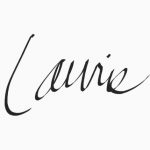Xchanges Gallery
My talk was well received, with questions and discussion at the close. I spoke extemporaneously throughout the talk. I have edited my original version, omitting formal opening remarks and thank you’s. Those good people know who they are!
I studied studio arts at both Langara College and the Alberta College of Art and Design in the 1970’s. I spent a year at the Victoria College of Art in 2001.
Three students and I formed a strong personal and creative bond that year at VCA. We opened The Store Studio, 1910 Store Street, where we had regular shows of our work for three years. It was a pivotal time for me.
I have had a studio practice for the past 25 years in one form or another in Victoria. My large well equipped studio and workshop are in Esquimalt. I have been able to spend much more time in the studio over that past 12 years. During that time I’ve been able to develop a large and diverse body of work.
Painting, printmaking, and drawing, including life drawing, are part of my core studio practice. I’ve been printmaking for about 10 years. Now, sculptural form is on my radar.
The beginnings of this broad body of work, Sewing Lessons, began germinating in 2014, and became my first print installation. It took root because of two events. I was walking through Walmart looking at toddlers dresses, and the next day I received a parcel of small dresses from my mother.
Here is the statement I wrote in 2014 after completing this installation. I published it on this blog. I think it bears repeating now:
September 2014
Many of the garments we choose to wear are produced in large factories far from home. The hands that work the cloth are unknown to us. In a generation, this shift has had a profound impact on the economy. And, it has shifted individual priorities.
In our global economy, women, men, and children find work sewing in clothing factories far from my home. Many of them comment they are happy to have the work. The conditions in many of these factories are less than ideal measured by Canadian standards.
Process and materials are revealed in this installation.
Sewing Lesson #2 are 12 intaglio and embossed dress images. The print has a childlike simplicity and echoes the pattern manufacturers’ name, Simplicity. This Simplicity text is seen in Sewing Lesson #1, a photo etched copper plate of the pattern pieces. Sewing Lessons #3 is my homage to the Canadian artist and printmaker, Betty Goodwin. This piece has an x-ray quality and suggests a memorial. On the machine is the small dress held under the metal foot. First, I screen printed the raw cotton material, then cut the pattern and sewed the dress on the machine. The photo etched copper plate of the pattern pieces is embedded in the sewing machine top beside the dress.

Sewing Lessons Installation copper etched plate, screen print dress on sewing machine
When I first showed this installation to a group of my colleagues, a comment was that the sewing machine reads as nostalgia. I took the work ‘nostalgia’ at that time as a pejorative. Perhaps my guard was up because studying fabrics at art college in the 1970’s was derided by much of the male student body, and instructors as well. I was in Painting and was witness to that culture.
If nostalgia is described as something done, or presented, in order to evoke a longing for the past, this work is not nostalgic, not about longing. It is, in part, about memory. The work also questions the global economy and divisions of labour. It reflects my curiosity about materials and methods of working.
Back to my mother: My mother sewed by first wool coat from her old coat. She made all my clothes from necessity. I opened the small worn old cardboard dress box she had mailed me, and folded back the soft white tissue paper. A powerful wave, the smell of memory, washed over me. I then remembered standing on our kitchen table while my mother pinned the hem of those small dresses.
The price of a toddlers dress at Walmart is about 12 dollars today. Machine sewing, and the attention to craftsmanship that comes with that, was the first hard skill I learned when I was 14. My mother enrolled me in Singer sewing school for the summer.
This body of work has been a journey of learning and making in printmaking, as well as painting and sculpture.
A word about printmaking process, and techniques: Photo etch, emboss, serigraph. These were printmaking processes I learned for the 2014 installation of Sewing Lessons. It was fascinating, addictive, time consuming, and often difficult. When I felt I had mastered those techniques, I became interested in expanding my print vocabulary.
I was researching hybrid printmaking and bought the excellent book by Paul Catanese titled Post Digital Printmaking. It was published in 2012, and reading it was like turning on a big bright light. I have since embraced computer numeric control (cnc) to engrave and laser etch plates. I also use the laser etch to create stencil forms.
It’s a relatively new term in printmaking, hybrid print. What is a hybrid print? For me, rather than being steered by a developed skill set, like etching, the work begins with ideas and seeks the most appropriate means to express them, included cnc and laser engraving*.
As the project progressed I found I was creating a conversation between the different elements in the body of work. This was also my process in the first Sewing Lessons Installation. The methods of printmaking are traditional. The copper plate embedded in the machine, and the screen printed and sewn toddlers dress reveal process and material. They are visual links to each other. The copper etched plate embedded in the top of the sewing machine cabinet was talking to the etching produced in the print.
That conversation continues with the silkscreen dress fabric pattern pieces seen again in the prints Number 5 Black and Number 5 White. There is also a conversation about fabrication and materials in Machine Alternations. The polyurethane copper-stitched pieces are speaking to the patterned prints. The cnc machined matrix of the print with the chine colle pattern pieces juxtaposes two forms of production. The prints and sculptures share analogous colours. The chined patterns relate to the embossed pattern on the skin of the sculptural objects on the aluminium shelf.
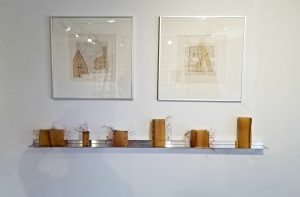
Machine Alterations 5 ‘ aluminium shelf, 6 embossed polyurethane copper stitched sculptures, 2 cnc engraved mono print chine colle 10′ x 10’ prints
My method of working in print is layering techniques and images. I use a matrix that I build on. I have used this approach in all the print work except for the three early works.
A word about the paintings: I had a big breakthrough about 6 months ago while I was painting. Painting is very different than printmaking for me. I was just kind of merrily painting, not over thinking. Staying in the zone where the work just flows. Then it hit me. I realized how closely related my painting work is to fabric. I had a big piece of Kente Cloth in the studio. I realized what was doing, and I smiled. It was the biggest painting smile I’ve ever had. And most importantly, I gave myself permission to follow that idea. I’ve always collected beautiful fabrics in my travels, kimonos from Japan, Thai hill tribe fabrics, batik. I treasure them. So I saw just how perfectly my paintings fit with Sewing Lessons. They are about texture, pattern, and colour. They are like a cheerful puzzle that somehow fits together.
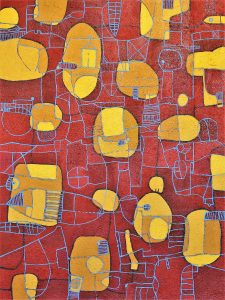
Smile 36″ x 48″ acrylic and pumice on canvas
You will see the paintings designs as the clothes of The Sample Family box piece. Here is playfulness and joy. The three large acrylic and pumice paintings have a cheerful intensity of colour, pattern, and are like fabric pieces. They are flat composition, textured, and non hierarchical. There is the same light hearted spirit in their whimsical companion piece, the wood case holding The Sample Family.
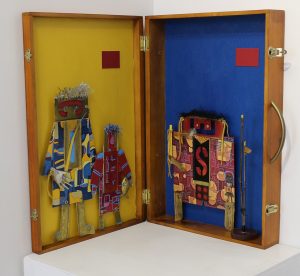
The Sample Family 42″ x 28″ wooden case mixed media
This work at its core is deeply personal given that my first clothing was sewn by my mother. This gives clothing, the objects next to our skin, a special relevance. The work is also in part about re purposing, manufacturing, and re imagining, and, the fragility of our environment.
The birch bark quilt Form Follows Function After Reason Over Passion and its companion piece 100 Canadian Stories are fragile companions. The same is true for the bamboo and sewn paper sculptures, Remnants S M L.
I can also say that Sewing Lessons, as a whole, is a project that addresses fabrication, mass production, craft, and economics. It has feminist, that is, human rights undertones. It is materials and process based. It is personal and autobiographical. It makes reference and pays homage to Canadian artists who influenced me during my student years, Betty Goodwin and Joyce Wieland.
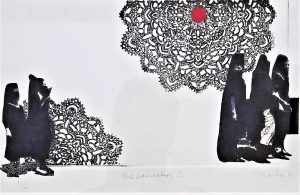
The Lacemakers 2 10″ x 13.5″ cnc engraving, monoprint, polyester photo plate chine colle
Let’s consider The Lacemakers print series down the concourse. Here is the seemingly ancient and hidden world of women workers threaded to their craft. What is the value of their work? Who are they? They are concealed beneath their garments. I lived in the Middle East in Abu Dhabi for three years, and had plenty of time to think about this. These figures raise questions about body politics in relation to cultural values and traditions when viewed through the lens of western culture.
Printmaking and painting come with a weight. The weight of tradition and art theory. Art institutions and schools, their curriculum and instructors, bring their own weight and agenda. I pay attention to those who use their position to be a voice, an arbiter, of the visual arts in our community. I am aware that every submission I make for a juried show comes with that weight. I have worked to develop my critical thinking about this in relation to my work. Mastering and understanding my way of working, what is true for me, has taken time. It is an agenda driven by the work itself.
This body of work has been a complex project. I have struggled to find words, or explanation, that can guide my audience to an understanding, and deeper reading of the work. I sought help with this and found someone who ably assisted me. I encourage every artist to seek help if they are struggling putting voice to the work.
I am fortunate to have such a person in my life. One of the smartest people I know, she is a critical thinker, teacher, scholar, published author, and, visually literate. She has been hanging out with visual artist for awhile, and she knows my work well. So she has helped to give me language. Writing is not always easy in visual art. There is the risk of over explaining and resorting to art speak.
I believe I have a responsibility as a visual artist to give voice to the work. I have spent time on that work and I know it best. I know it in context of how it fits with the culture and, how it fits with my art practice values.
It is not my wish to conceal or obfuscate my work through complex academic language, but rather through layers of description that are multi-dimensional, like people themselves. Every viewer brings their own experience to the work. I also want to place value on, and respect the mystery of, my visual language.
This body of work has been described as a meta narrative. An overarching story that gives meaning to my experience. Or, a story about a story. This is my story, from creation and conception, to construction and craft. The pieces fuse an old narrative to the new world through old and new technologies. The traditional printing press and painting on canvas work alongside laser cut forms, laser etching, and cnc machined plates. A mix of materials and images contrast the natural and built environments. At the same time, each piece undermines its own story by the questions that it evokes. My studies are a complex call to consider the material world: who makes it and how it dys/functions in modern life.
22 prints, part of Sewing Lessons, is also on display in Burnaby, through the Burnaby Art Gallery’s satellite space at the Bob Prittie Library in Metrotown. It’s there til May 27.
I have a show at arc hive June 5 to 23rd. arc hive is another artist run space in Rock Bay. The show is called Unknown Limits and will include installation, photography and paintings.
*Many people at the gallery had questions about cnc and laser etching. You can learn more about this, and develop many other skills at Victoria Makerspace. It is a member-operated shared space where people come together and collaborate while sharing tools, resources and knowledge. makerspace.ca
I appreciate any comments you have about my talk/statement. Please don’t hesitate to contact me.
And, you can find more of my work and process on Instagram @lauriemackieeditions
